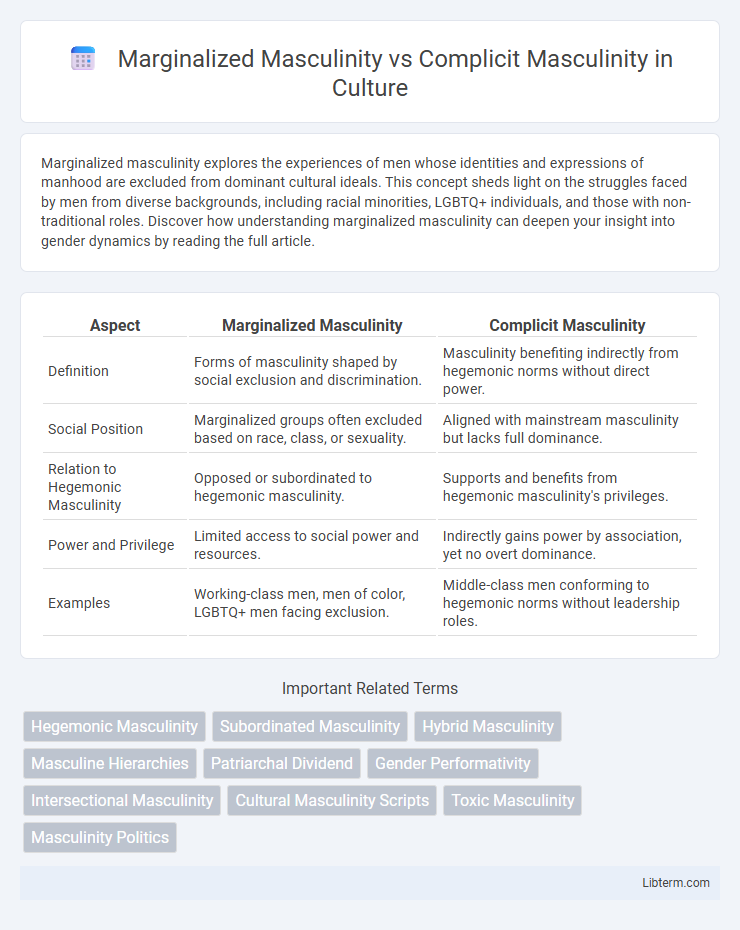Marginalized masculinity explores the experiences of men whose identities and expressions of manhood are excluded from dominant cultural ideals. This concept sheds light on the struggles faced by men from diverse backgrounds, including racial minorities, LGBTQ+ individuals, and those with non-traditional roles. Discover how understanding marginalized masculinity can deepen your insight into gender dynamics by reading the full article.
Table of Comparison
| Aspect | Marginalized Masculinity | Complicit Masculinity |
|---|---|---|
| Definition | Forms of masculinity shaped by social exclusion and discrimination. | Masculinity benefiting indirectly from hegemonic norms without direct power. |
| Social Position | Marginalized groups often excluded based on race, class, or sexuality. | Aligned with mainstream masculinity but lacks full dominance. |
| Relation to Hegemonic Masculinity | Opposed or subordinated to hegemonic masculinity. | Supports and benefits from hegemonic masculinity's privileges. |
| Power and Privilege | Limited access to social power and resources. | Indirectly gains power by association, yet no overt dominance. |
| Examples | Working-class men, men of color, LGBTQ+ men facing exclusion. | Middle-class men conforming to hegemonic norms without leadership roles. |
Defining Marginalized Masculinity
Marginalized masculinity refers to male identities shaped by social exclusion, often influenced by race, class, or economic status, limiting access to dominant masculine ideals. This form of masculinity exists on the periphery of hegemonic masculinity, confronting systemic inequalities that prevent full participation in traditional power structures. Understanding marginalized masculinity is crucial for analyzing how intersecting social factors redefine male roles and identities outside the dominant cultural norms.
Understanding Complicit Masculinity
Complicit masculinity refers to men who do not exhibit dominant or hegemonic traits but still benefit from the patriarchal system through their alignment with traditional male privileges. These men support and uphold gender norms indirectly by accepting existing social advantages without challenging hegemonic masculinity. Understanding complicit masculinity is crucial for analyzing how power structures maintain gender inequality beyond overt displays of dominance.
Historical Roots of Masculinity Hierarchies
Marginalized masculinity and complicit masculinity stem from historical patriarchal structures that established rigid gender roles and hierarchies, privileging dominant, often white, middle-class masculine ideals. Marginalized masculinities arise when men are excluded from these dominant norms due to factors like race, class, or sexuality, while complicit masculinities benefit indirectly by supporting and perpetuating the status quo without actively embodying hegemonic masculine traits. Understanding the historical roots reveals how power dynamics and social inequalities shaped diverse masculine identities within a hierarchical framework.
Social Power and Masculinity Dynamics
Marginalized masculinity reflects men who experience diminished social power due to race, class, or sexual orientation, positioning their masculinity outside dominant hegemonic norms. Complicit masculinity involves men who do not fully embody hegemonic masculinity but still benefit from its privileges by aligning with dominant societal expectations. The dynamics between these masculinities reveal how social power shapes men's access to authority and influence, reinforcing hierarchies within gendered identities.
Intersectionality: Race, Class, and Gender
Marginalized masculinity emerges at the intersection of race, class, and gender, reflecting how socially oppressed groups experience gender identity through systemic exclusion and economic disadvantage. Complicit masculinity aligns with dominant masculine norms, benefiting indirectly from privilege linked to race and class, despite not fully embodying hegemonic masculinity ideals. Intersectionality reveals how these masculinities operate within layered power structures, highlighting disparities shaped by racial oppression, socioeconomic status, and gender expectations.
Marginalization in Media Representations
Marginalized masculinity in media representations highlights men who deviate from dominant norms, often portrayed as weaker or less authoritative, reinforcing societal power imbalances. These portrayals contrast with complicit masculinity, where men benefit from hegemonic male privileges without actively challenging dominant gender norms. The persistent marginalization in media restricts diverse masculinity expressions, perpetuating stereotypes that limit social acceptance and reinforce traditional gender hierarchies.
Complicity and Social Privilege
Complicit masculinity involves men who benefit from patriarchal systems and social privileges without actively embodying dominant masculine traits, maintaining power through conformity and indirect support. This form of masculinity perpetuates gender hierarchies by aligning with societal norms that favor male dominance and privilege. Social privilege in complicit masculinity manifests through access to resources, opportunities, and influence that marginalize other masculinities and genders.
Consequences of Masculinity Marginalization
Marginalized masculinity results in social exclusion and diminished access to power, often leading to psychological stress and limited economic opportunities for affected individuals. Complicit masculinity, while embracing dominant gender norms, indirectly perpetuates inequalities by benefiting from patriarchy without overtly challenging marginalized groups. The consequences of masculinity marginalization include internalized inferiority, increased vulnerability to violence, and restricted social mobility.
Challenging Traditional Masculinity Norms
Marginalized masculinity challenges traditional masculinity norms by highlighting the experiences of men excluded from dominant masculine ideals due to race, class, or sexuality, thereby questioning the universal applicability of hegemonic masculinity. Complicit masculinity supports existing power structures by benefiting from patriarchal privileges without actively embodying hegemonic traits, maintaining status quo gender hierarchies. Both concepts critically expose the limitations of conventional masculinity, promoting broader understandings and inclusivity in gender roles.
Toward Inclusive Masculinity Narratives
Marginalized masculinity refers to men excluded from dominant masculine ideals due to factors like race, class, or sexual orientation, while complicit masculinity describes those who benefit from and uphold traditional patriarchal norms without actively embodying hegemonic traits. Toward inclusive masculinity narratives, scholars advocate for embracing diverse masculine identities that challenge exclusionary norms and foster acceptance across social differences. These narratives promote healthier expressions of masculinity by undermining rigid hierarchies and encouraging emotional openness and equality.
Marginalized Masculinity Infographic

 libterm.com
libterm.com